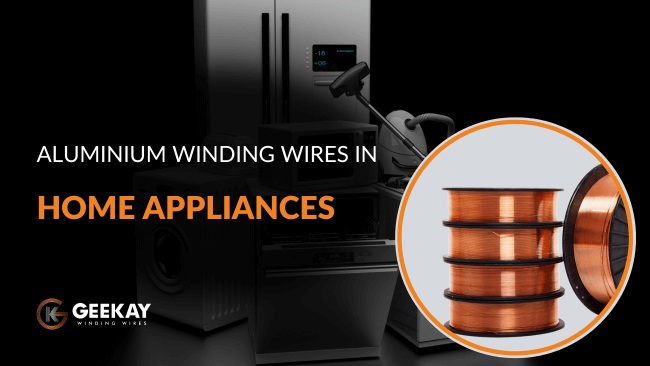Rising economies and improved lifestyles have changed consumer preferences when buying home appliances. They look for effectiveness, stylish design, sustainability, energy efficiency and smart functionality that can improve their quality of life.
As a home appliance manufacturer, it is time for exponential growth by innovating to meet consumer trends. Choosing the right components can help you deliver the best product to consumers at an affordable rate while keeping your profit margins high.
One such component in home appliances is the winding wire.
Winding Wires in Home Appliances
Every electrical or electronic appliance needs a winding wire as an integral component to transfer electrical energy to another form. Whether it be motors in fans, mixer grinders, washing machines, dishwashers, food processors, or solenoids in vacuum cleaners, HVACs, refrigerators, etc.
And for the smooth functioning of these appliances, the winding wire should perform as per the specifications. Enamelled copper winding wires are often used in this regard for their efficiency, compactness, and long life.
However, things are changing, and of late, aluminium is preferred over copper in home appliances for its special properties.
Reasons for Growing Use of Aluminium Winding Wires in Home Appliances
Here are some reasons that make Aluminium winding wires superior to copper winding wires for Home Appliances.
Cost –
Copper is a rare earth metal and hence it is costlier. This pushes your manufacturing cost higher and makes the product less affordable to most population. On the other hand, aluminium is available in plenty, making it cheaper than copper.
Lower Eddy current losses –
Aluminium has higher resistance. This, in a way lower the eddy current losses, thus preventing the formation of hotspots.
Resistance to corrosion –
The aluminium surface exposed to air forms a thin oxide layer. This has an insulating nature and prevents air, water, and moisture from coming in contact with the metal, thus resisting further corrosion. In the case of copper, the oxidisation on the surface can get all through the metal, leading to corrosion of metal parts not exposed to air.
Customer Satisfaction –
Aluminium is a lightweight metal and hence home appliances using aluminium winding wires will be easier to handle for consumers when compared to those with copper winding wires.
Flexibility –
Aluminium winding wires are quite flexible making the winding process easy. By following the best winding practices, the process rejects can be brought to a minimum, further reducing your manufacturing cost.
Now here are some characteristics of aluminium winding wire that make its performance quite comparable to that of copper.
Performance of Aluminium Winding Wire vs Copper Winding Wire
Conductivity –
The conductivity of Copper at 20 °C is 5.96×107 S/m
The conductivity of Aluminium at 20 °C is 3.77×107 S/m
Though the conductivity of Aluminium is lower than copper, winding wires made of aluminium can generate a stable magnet flux required for the proper functioning of home appliances. The efficiency is acceptable for applications that are used occasionally and for a shorter duration.
Enamel Coating –
The electrical, thermal and mechanical properties required for winding wires are achieved by coating the metal wire with enamel. Just like Copper, Aluminium can be coated with most enamel types like – polyvinyl formal or Formvar (PVF), polyurethane, polyamide (PI), polyester (PEW), polyester-polyimide (EIW), polyamide-polyimide (or amide-imide) (AI-EIW), and polyimide (AIW).
Good Breakdown Voltage –
Aluminium winding wires offer good breakdown voltage (BDV) just like copper winding wires. The BDV is dependent on the thickness of the insulation. Higher the thickness, the better the breakdown voltage.
In a nutshell, by switching to Aluminium winding wires, you get the more or less the same chemical, dimensional, thermal and electrical properties (except resistance) as that of copper winding wires, at a lower cost. This good performance makes aluminium wires best suited for small to mid-sized magnet wire applications.
This explains the growing popularity of aluminium winding wires as a preferred choice for home appliances.
Having said so, there are a few key points to note while selecting an aluminium winding wire manufacturer.
Things to note with Enamelled Aluminium Winding Wires
By definition, the classes of insulation for both copper and aluminium are the same, but some classes in copper do not have corresponding standards in aluminium. This is probably because aluminium winding wire is relatively new and standards are being created and revised as per requirement.
Due to the relatively poor adhesion of insulation to aluminium conductors, special care is needed during the enamelling process. Proper cleaning of the aluminium conductor surface before enamelling ensures strong insulation adhesion.
Otherwise, the enamel could break off easily during winding or may not conform to the desired temperature class. This could cause heating or premature breakdown of the home appliance affecting your brand perception. Hence choosing the right enamelled winding wire manufacturer matters.
Choosing an Aluminium winding wire manufacturer
Geekay is an established winding wire manufacturer since 1975. We source pure aluminium and enamel from the best suppliers. Also, we follow strict quality controls to ensure that the winding wire that we deliver to you is of the exact same specifications as quoted.
All the more, our strategically located manufacturing units and dealer network ensures timely delivery to your factories. Also, our infrastructure supports scalability in production as per your needs.
Contact us with your requirement and specifications of aluminium winding wire for home appliances production.


